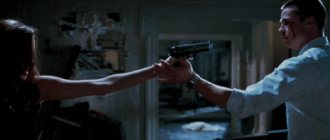Many parents cannot calmly look at the “creations” of their children in primary school. Neither copybooks nor additional classes help - the handwriting remains terrible, the letters spread out to the sides, do not fit into the lines, and it is sometimes extremely difficult to read what the child has written. Today we will discuss how to teach a child to write beautifully and accurately. How not to scream and not bring either yourself or your young student to tears? It turns out there are ways.
Often children argue for their bad handwriting by saying that they hardly need it. After all, almost everything in today’s world is in electronic form: SMS, printed abstracts on a keyboard, etc. But still, beautiful handwriting has never been canceled! Parents must turn calligraphy into a fun activity, otherwise over time they will not be able to make out a single letter in their child’s notebook.
The importance of good handwriting for school
Today, in the age of universal computerization, many parents may underestimate the importance of good handwriting for a schoolchild (after all, in adulthood, texts are typed on a keyboard). However, this opinion is wrong, and the ability to write beautifully is of great importance for a child:
- In elementary school, teachers often reduce grades precisely for careless handwriting. And this is not their whim, but compliance with the criteria developed by the Ministry of Education. As a result, a child can receive four (or even three) points even for a correctly solved math test or a written answer on the world around him. In addition, the teacher sometimes cannot understand spelling (“a” or “o”), and grades in the Russian language are further reduced.
- If a student gets used to writing incomprehensibly, then often at home he cannot make out his own handwriting.
- When passing the State Examination and the Unified State Exam, tests filled out in beautiful handwriting will not raise questions from the inspectors.
In elementary school, teachers have the right to reduce grades precisely for careless handwriting, and not only in the Russian language
Problems with handwriting in children can be very different: for example, for some the letters “dance” above and below the line, for others they differ in width and height, for others they are so similar that it is impossible to distinguish, for example, “and” from “ n" or "k" from "p".
Working with large texts
After the child learns to accurately write letters and learns the rules for combining them in words, you can move on to working on entire texts, which are an indicator of handwriting. Still, the ability to write a beautiful letter does not guarantee beautiful handwriting when writing long sentences.
Younger schoolchildren usually have tasks to rewrite texts, the first presentations and dictations appear very quickly, but at home such work can be turned into the same game.
For example, you can write letters with your child. Thus, messages will be received by Father Frost, and the Snow Maiden, and grandparents, and many more people to whom the child will want to write a real paper letter, packed in an envelope with drawn or pasted stamps.
Another trick is to ask them to rewrite some text. It is advisable that this be a handwritten text, written in clear block letters by someone of their parents. The child will probably be flattered by the request to rewrite the existing text beautifully, and he will try his best to achieve a truly attractive result. This trick is suitable for children of all ages - toddlers and primary schoolchildren to older children in fourth and fifth grades.
Problematic aspects of calligraphy
Poor handwriting in children can be caused by:
- erroneous motivation or lack thereof;
- fear of doing something wrong, upsetting parents or teachers;
- haste, distracted attention, lack of concentration;
- incorrect positioning while writing;
- lack of interest in this activity and learning in general.
Lack of accuracy can be caused by even such a banal factor as weakness of the hand muscles. Due to insufficient preparation, a first-grader’s hands quickly get tired, but at the same time he cannot drop everything and put the notebook aside right in the middle of the lesson. As a result, he does not think about the correctness and beauty of what is written, but simply does what he is told, but less carefully.
The reason for poor writing may also be that the student initially writes slower than his classmates, and the teacher, as you know, focuses on the bulk of the children when teaching a lesson. But regardless of the provoking factors, parents who notice a problem in their baby can quickly fix everything.
We monitor the correct position of the hands
In order for a child to learn to write beautifully and legibly, he should be taught to place his hands correctly. Personally, I had to spend some time explaining the importance of this to the child, but once she understood the information, things quickly improved.
Among other things, it is important to teach the child to hold the notebook at a slight angle (10-15 degrees) - this is the only way to ensure easy and fairly quick sliding of the hand while writing text.
The main reasons for bad handwriting
- Incorrect position of the body and notebook when writing
. Handwriting, in which the letters have an incorrect slant and the elements of the letters are not parallel, is formed in children who sit incorrectly at the desk. With such a fit, the letters “n”, “k”, “p”, “i” can be very similar and difficult to distinguish, and the lines are uneven: they either rise above the ruler or descend below. - Wrong choice of pen
. An incorrectly selected pen can ruin a child's handwriting. It should be comfortable, not requiring excessive strain on the fingers and hand. - Insufficiently developed muscles of the hands and fingers
. Often the problem that prevents primary schoolchildren from writing beautifully and quickly is the poor development of fine motor skills. Kids simply lack the flexibility and dexterity of their fingers to write neat handwriting. Signs of this problem may include incorrect spelling of rounded elements of letters (they become pointed) and different sizes of letters. - Developmental disorder of spatial perception
. The presence of this problem is indicated by the following signs: non-compliance with the spacing between letters in a line, uneven distribution of words along a line, text extending into the margins of the notebook, lines not written to the end of the page, non-compliance with the boundaries of the red line. A child can confuse optically similar letters - “b” and “d”, “x” and “zh”, “p” and “t”, and also write letters in a mirror image. Typically, children with this disorder are slow and cannot keep up with the teacher, and their handwriting becomes even worse from excitement.
Strong back
It would seem, how are physical education and sports connected with beautiful handwriting? It turns out that the connection is direct! A straight back, a strong shoulder girdle, reliable posture, all this will allow the child to sit at a desk or desk correctly and levelly.
And the posture during writing also affects handwriting. It will be difficult to write beautiful letters while lounging on the tabletop or bent over.
So, “Get ready to exercise!” A simple daily set of morning exercises will bring your child closer to beautiful handwriting. There is a separate article dedicated to exercise on the Shkolala blog, be sure to read it.
Correct fit
When performing written exercises, the child must sit at the table in a certain way:
- The back is straight, and the shoulders and neck are relaxed.
- Your hands are on the tabletop, but your elbows are not touching it.
- The distance from the tabletop to the child’s chest should be approximately equal to his palm: no need to lean on the table or move too far away from it.
- Feet are level on the floor; it is good to use a special stand. If you cross them or throw them on top of one another, the spine becomes bent.
Correct grip of the handle
The right pen is only half the battle. You need to teach your child to hold it correctly. The handle should lie on the upper phalanx of the middle finger and be fixed with the thumb and forefinger. The tip of the handle should be pointed towards the shoulder. To teach proper grip, you can use the following methods:
- The child takes the pen by the upper tip with three fingers (thumb, middle and index), holding it vertically. Then the fingers slide down, about 2 cm short of the tip of the rod. The pen lies correctly, the ring and little fingers remain free and slide along the paper, providing support for the hand.
- Draw a bright dot on the baby’s middle finger in the place where the finger should touch the handle. You can make a mark on the handle itself (for example, using tape), below which your fingers cannot be lowered.
- You can use a regular rubber band . One end is wrapped around the handle approximately 2 cm from the top edge. The child threads the brush into the resulting free loop from top to bottom. An elastic band wrapped around the wrist tightens and prevents the baby from grasping the hand incorrectly. In addition, such a simulator will help strengthen the arm muscles.
- a paper napkin folded in four to his palm with his ring and little fingers, and takes the pen with the other three fingers. In this position, the little finger and ring finger cannot take part in holding the pen.
"Self-taught pen"
Let's not forget about a special device called a self-taught pen. This is a handle on which you can put a special attachment. The attachment most often looks like a beautiful toy. It is simply impossible to grasp a handle with such an overlay incorrectly. We haven't tried it ourselves, but we've heard a lot of positive reviews.
Developing fine motor skills
The muscles of the student’s hand must be ready for the loads that writing involves. And it is best to train them long before entering first grade. Entertainment activities will help with this (they only bring pleasure to kids):
- drawing (especially in cells), coloring pictures with pencils (it is better not to offer felt-tip pens, they require minimal stress on the arm muscles);
- modeling from plasticine, clay, salt dough;
- working with scissors (cutting snowflakes, parts for appliqués, etc.);
- construction using small parts (Lego, etc.);
- mosaic games;
- sorting through cereals, practicing with kinetic sand;
- shadow theater games;
- origami;
- Beading and crocheting are suitable for girls.
Exercises for training the muscles of the back, shoulder girdle and arms.
1. Attach a piece of paper to the wall and draw in this position;
2. Walk around the room with a book on your head;
3. The child walks on his hands, and the adult holds his legs;
Exercises to develop spatial perception.
If the letters seem to “hang in the air,” the child’s spatial perception may be underdeveloped.
Graphic dictations will help, games in which you need to find something, following the instructions of an adult (for example, go straight, now turn left, etc.)
Example of graphic dictation
Tweezers technique
In order for my daughter to learn to hold the handle correctly, I suggested that she place the tool with the shaft down and lightly grasp it with straight fingers. Next, you should slowly move your fingers down - at one moment your fingers will take the correct position in which to carry out the writing process.
I can say that this simple exercise helps a child understand how to hold a pen correctly. As soon as the child has difficulty grasping the handle, she immediately performs such a simple trick with it.
The mother of my daughter’s classmate said that her boy also faced the same difficulty as us. They solved it with the help of a self-taught pen - a very interesting stationery item, the use of which is a real joy for a child. I can say that its use is an excellent alternative to all other techniques for mastering the correct grip of a tool.
Methods for training the correctness and calligraphy of writing.
In order to see results, classes must be held every day.
Working with copybooks and coloring books
For classes on developing or correcting handwriting, it is necessary to purchase copybooks for the child, where the outlines of the letters are indicated by dotted lines. Working with copybooks can be divided into several stages:
- The kid traces the contours of the letters in the copybook.
- The child is given the task of repeating the spelling of a printed letter or word following a pattern on the same line. You can move on to each subsequent letter only when the previous one begins to work out perfectly.
- The child rewrites individual sentences and entire texts, first in lined letters, then in a regular notebook without oblique rulers. The exercise should become daily, with rewriting small paragraphs of text.
For graphic classes, coloring books with outlines of various shapes, lines and patterns are suitable. For coloring, it is better not to use felt-tip pens, but to give your child colored pencils. They develop fine motor skills better because you have to press on them. It is necessary to ensure that the pictures are painted neatly and evenly, within the contour lines.
You can not only paint over drawings, but also shade them. You need to ask the baby to do this in different directions - vertically, horizontally and diagonally. It is necessary to ensure that the child does not turn the sheet over when moving from one direction of shading to another, but only moves his hand.
It is useful to use dotted lines that need to be traced. This exercise develops the accuracy of hand movements.
Another option is mirror drawing. The child, looking at the image of half of the picture and counting the cells, must complete the second part of the symmetrical picture.
Gymnastics for arms
Gymnastics for the hands prepares the child well for writing and relieves fatigue and tension in the hands that may occur when writing.
Drawing by cells
During such drawing, the hand is prepared for writing, and attention, accuracy and spatial perception are also developed.
Should I learn to write before school?
Some parents begin to teach their child to write, as well as read, from an early age, guided by their ambitions or fashion trends. However, it has been noticed that such children’s handwriting often deteriorates subsequently. Even if at first the baby gets beautiful letters, this skill needs to be practiced long and hard, which is beyond the power of the baby even in purely physical terms.
Thus, there is no need to rush to start calligraphy classes with your preschooler. Let the teachers at school do this. It is important for parents to practice writing each letter at home.
Before school, it is advisable to train your child not to write letters, but only their constituent elements: sticks, hooks, curves, etc. It will be easier for the child in the first grade.
Before school, it is better to teach your child to write not individual letters, but their component elements (hooks, sticks, etc.)
The right pen is the key to success
Now we will not talk about the beauty of the writing instrument, but about its convenience. When choosing a pen, I was primarily guided by the physiology of a child’s hand. What is truly amazing to me is the fact that parents, when buying heavy, irregularly shaped pens, expect their child to write beautifully. In my opinion, you should always remember that at first the beauty of a writing instrument is not at all the main thing.
Russians trust signs: for example, look in the mirror if you have returned
Elizabeth Taylor's pets. Retro photo of celebrity with cute cats
The summer season is just around the corner: how to propagate currants on the windowsill
Modern stationery manufacturers offer a large selection of pens with different types of refills. I give preference to ballpoint pens, since, in my opinion, they are more reliable in the writing process (gel pens quite often fail because at one point they stop writing and begin to scratch the paper). When buying a pen for my daughter in a store, I make sure that the shaft glides easily across the paper and leaves a greasy mark.
I decided that in primary school my child would not use completely plastic or metal handles - both of them are not very convenient to use, since after 5-10 minutes of use the fingers begin to slip on them. In turn, I prefer accessories with a rubber insert.
Teaching writing to children who write with their left hand - features
Most parents are very worried that they will not be able to teach their left-handed child to write beautifully, since he cannot hold a pen like ordinary children. It is considered a big mistake to teach your left-handed child to hold a hand and sit the way right-handed people do.
Left-handed desk
The arrangement of various objects on the table for a left-handed child is slightly different:
- The light source must be on the right;
- Notebooks must lie in a mirror image - straight or tilted to the right;
- In the process of filling out the pages, the notebook moves up.
Not very convenient for left-handed people, in a school where all classroom equipment is mainly aimed at right-handed students, the main source of lighting is located. It is very easy to solve this problem; it is enough to seat a left-handed student on the left side of the desk, near the window.
Correct orientation in the notebook
Quite often, left-handed people confuse the sides of notebooks, so they need to mark their pens with watches or bracelets.
The most common mistake not only by teachers, but also by parents is that they force the child to write with the standard tilt of the letter to the right; doing this is strictly prohibited, since it is much easier for the child to write straight.
Writing technique.
- 1. If for right-handers they created notebooks in a narrow line with an appropriate slope, then left-handers now have their own notebooks with their own slope. This means that it is impossible to force a left-handed person to write letters slanted to the right. Left-handers write either straight or slanted to the left. This makes the work much easier for the hand.
- 2. To prevent the child from smearing the ink, you can put another piece of paper under your hand, and buy thin pens with non-greasy ink.
- 3. There are also special attachments for left-handers, special pens with a curved shaft, table pads for the correct position of the notebook and hands when writing.
The main thing when teaching a left-handed child to write is to develop motor skills and spatial coordination, as well as the skills listed above. The process of mastering writing with the development of these skills will not differ for left-handed people from right-handed people. You only need to follow some fundamental rules listed in the second part of the article.
The main mistakes left-handed children make when writing and how to correct them
How to teach a left-handed child to write correctly and without unnecessary nerves? Left-handers tend to have a more noticeable tendency towards dysgraphia. And therefore, all actions and methods of teachers and parents must necessarily be aimed at preventing various shortcomings:
- Mirror writing;
- Ignorance of where to start writing correctly;
- Tendency to go down and up from the lines;
- Violation of writing a sequence of letters;
- Writing missing and extra letters.
Correction and prevention of various calligraphic defects includes copying diagrams and pictures. You should also pay attention to the fact that in the process of completing tasks, a left-handed child does not turn the details of the drawing in the opposite direction. Applied arts classes can have a great effect: drawing patterns, appliqué, embroidery.
Recommended themes for work are floral, geometric and animal patterns. Such types of creativity are mainly characteristic of folk crafts - painting toys and various dishes, embroidery and sketching. Scissors for left-handed people make manual labor much easier.
Quite effective notebooks are copybooks for left-handed children, the latest new technique in surveys on how to properly teach a left-handed child to write. Various teaching aids for parents, developmental notebooks, and conversations with teachers can help left-handers more easily adapt to school and become a successful student.
Advice for adults
It is difficult for adults to relearn writing. If a person is used to writing quickly in an incomprehensible handwriting, then it will be difficult for him to switch to smooth calligraphy with every line drawn.
Note! Many people think that it is easier for girls to learn beautiful handwriting. This is due to perseverance, diligence and desire. Guys often give up halfway, although everything comes much easier to them.
Writing Tips for Adults:
- Choosing a pen that will fit perfectly in your hand.
- There should be a sheet of paper and a pen at the workplace, nothing more.
- The correct position is a straight back, hands on the table.
- The leaf should be 30 cm from the eyes.
- When writing, you need to write letters several times to choose the most successful option.
- Daily writing. You need to write every day. It is better to keep a special note with articles and essays written by hand.
Not many people are gifted with beautiful writing, but if you try, you can learn it. In order for it to be literate and without errors, it is important to read different books and poems.
A well-read person does not make mistakes on a subconscious level and writes words correctly.
Remember that beautiful calligraphic handwriting can create a good impression of others about you.
Useful video
Share this post
- Related Posts
- What are the medicinal properties of burnet and how to use it correctly
- What do hedgehogs eat at home and in the wild: list
- Vulgar, interesting, tricky, provocative and funny questions that you can ask a girl to get to know her better
- The highest and largest waterfall in the world: where it is located and its description
- How and with what to remove small midges from indoor plants: methods
- How to name a cat in an original way in Russian, Japanese and English, and what the meaning of nicknames is
Stages in teaching writing to left-handed schoolchildren
Left-handed people have a much harder time mastering writing than their right-handed counterparts. The problem is complicated by the lack of enthusiasm due to their psychological characteristics. At the slightest failure or criticism, the student is ready to quit work and even hate calligraphy.
How to teach a left-handed person to write? To develop lasting skills, you need to follow the algorithm for working with new material.
Introducing the letter
- tell us what elements the new letter consists of;
- show how and in what order it is written;
- When demonstrating writing, it is advisable to use a felt-tip pen, as it gives a clearer trace and shows the sequence more clearly.
Passive practical part
Having learned how to write a new letter, a left-handed person is not yet ready to use a pen. Invite him to guide your hand. Let him tell you what to do, and you will do it.
Active practical part
Now let the left-hander write himself. At the same time, observe vigilantly and try not to interfere unnecessarily. Commenting out loud should accompany all the actions of a left-handed student until he becomes comfortable enough to work silently.
Consolidation of the educational effect
You can teach left-handed writing and consolidate the material using such a method as analyzing what you have written. The child must think and tell what he did well and where he made a mistake.
To optimize learning to write, a table such as the capital alphabet with letter writing patterns is useful. The direction and order of writing is shown using arrows and numbering of actions.
These posters are very rare. Therefore, you can buy a simple capital alphabet and complete it yourself.
Working with geometric shapes
You can get rid of uneven lines and uncertain movements with the help of simple drawing. To do this, it is not even necessary to require any complex paintings from the child; just simple work with geometric shapes is enough. So, for example, a child can first trace and then try to draw circles, squares and various triangles on his own. To prevent such activities from seeming boring, you can put together different designs from geometric shapes or ask the child to come up with some compositions from them - a snowman made of circles, a house made of a square and a triangle, a New Year tree made of triangles with round ball decorations.
It is when working with correct geometric shapes that the child will learn to keep an even line and even maintain established proportions (for example, draw triangles of the same size). Such an exercise will be useful both for very young children and for younger schoolchildren, for whom constant handwriting training is important.











